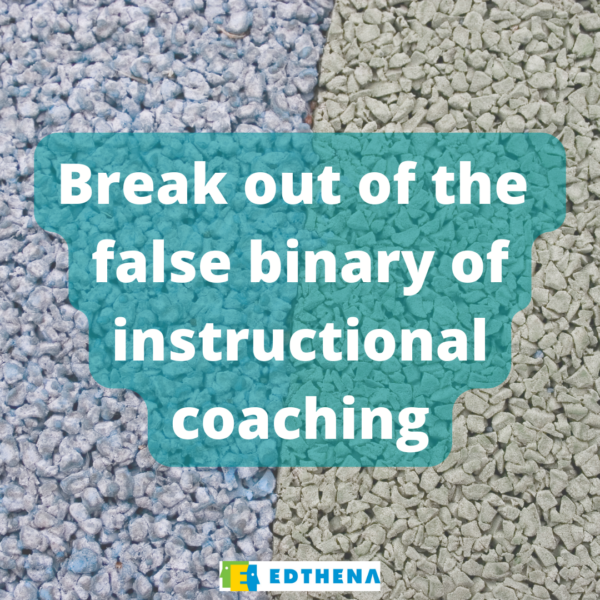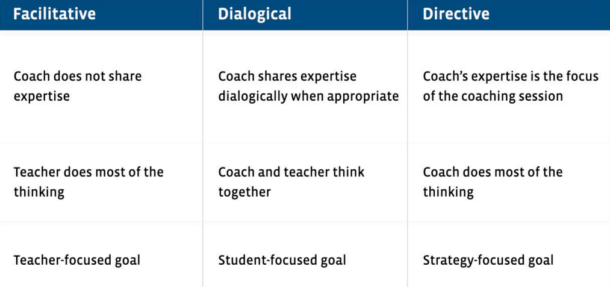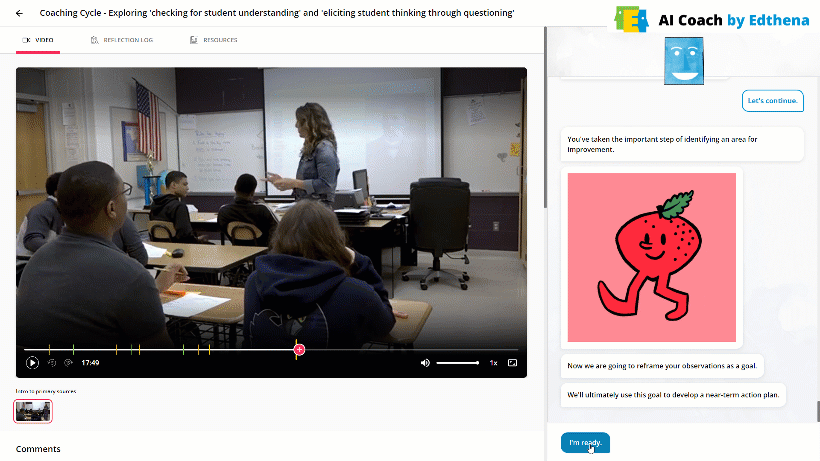Stuck Between Facilitative and Directive Coaching? The Virtual Coach is the Best of Both
We built the AI Coach platform to support teachers’ growth in-between working with an instructional coach. But coaching can look different to different people.
Two common coaching stances, directive and facilitative, are often viewed as opposite ends of a coaching spectrum. Directive coaching has heavier input from an instructional coach, while facilitative coaching is more hands-off.

However, teacher coaching doesn’t need to be just one or the other.
Edie, the virtual coach inside the AI Coach platform, might be made up of 1’s and 0’s, but she doesn’t fall into the false binary.
Rather, she takes a collaborative approach to working with teachers. This sweet spot for coaching, a more hybrid approach to facilitative and directive coaching, is how Edie effectively supports teachers.
We’ve explained how and why Edie coaches the way she does. Learn all about the way the virtual coach takes the best of various teacher coaching styles.
The spectrum of directive coaching to facilitative coaching
It’s helpful to think about the approaches to instructional coaching as a spectrum.
Directive coaching is when a coach provides teachers with suggestions and explanations of what to do. This is fine at times when a teacher needs an idea for classroom solutions, such as a particular strategy for checking student understanding.
Facilitative coaching conversations, on the other hand, provide less input from the instructional coach.
According to Jim Knight of the Instructional Coaching Group, “Facilitative coaches do not share their expertise or suggestions with respect to what a teacher can do to get better … However, it is less effective when teachers do not have the knowledge they need to address issues in the classroom.”

Sometimes productive struggle is good but teachers don’t want to feel like you’re hiding the solution from them.
Both of these coaching stances have their place. Having an either/or attitude, however, is limiting.
Rather than the binary thinking of just directive coaching or just facilitative coaching, leading coaching thinkers support a more powerful, hybrid approach.
The AI Coach platform hits the sweet spot for coaching teachers
Jim Knight calls the important middle-ground for coaching teachers dialogical coaching.
Elena Aguilar calls the middle ground between facilitative and directive coaching transformational coaching.
Whatever the label, this middle-ground for coaching focuses on a coach mediating teacher thinking while also being a resource if the teacher hits a roadblock in their analysis.
This is where Edie, the virtual coach, is in the sweet spot for teachers.
When it’s time for teachers to decide on a goal, the AI Coach platform’s virtual coach doesn’t slip into directive coaching: Edie doesn’t tell teachers what to do. Rather, she lets the teacher decide.
Based on the important elements from the facilitative coaching model, Edie doesn’t claim to be the source of all the answers. This doesn’t mean that when it’s time for teachers to develop a next-step goal, she sits back quietly.
Instead, Edie guides teachers’ thinking by asking teachers to select one area to work on so they are focused on a single, specific goal. This supports teachers to uncover how they want to target their professional learning.
Edie also actively invites teachers to share their own reflections on their teaching practice. Just like an instructional coach, she asks multipart, open-ended questions that help teachers craft an action plan incrementally and form their own solutions.

This helps teachers drive their own learning while simultaneously providing them the support of a facilitator who’s actively guiding their reflective journey.
The virtual coach is not stuck in the facilitative stance, however. There are moments when Edie offers to collaborate with teachers on the solution by providing curated and targeted resources. When a teacher isn’t sure what strategies will help them make progress toward a specific classroom goal, the virtual coach offers relevant strategies and ideas.
Similar to dialogical coaching, Jim Knight explains that this supports the understanding that “issues teachers face in classrooms can often be better addressed if teachers look at what research has identified as effective teaching strategies. Therefore, like directive coaches, [dialogical coaches] have a deep understanding of teaching strategies they can share with teachers to help them improve.”
Edie isn’t doing the thinking for teachers. Instead, she IS sharing access to knowledge that can help teachers make decisions for their classroom action planning process.
Edie’s role as a virtual coach is in the Goldilocks Zone between directive coaching and facilitative coaching.
Taking a hybrid approach to instructional coaching
The virtual coach’s approach in our AI Coach platform is based on research about the way educators best learn and grow.
The most helpful form of coaching is not about choosing between directive coaching and facilitative coaching. A healthy balance of coaching approaches is key to most effectively supporting teachers.
The power of the AI Coach platform is its virtual coach Edie, who is able to deliver a supportive, conversational approach reliably to every teacher, every time.
Want more insights from Jim Knight? Check out this blog post about the Impact Cycle & PEERS goals.
Want to try out the AI Coach platform for yourself? Sign up for access here.
